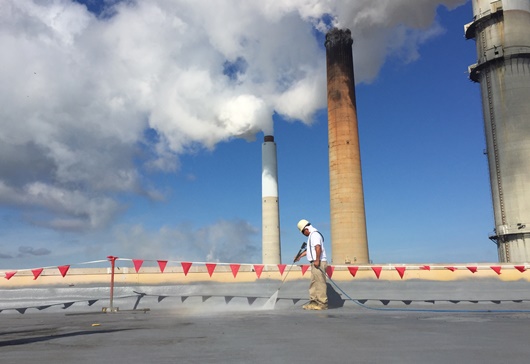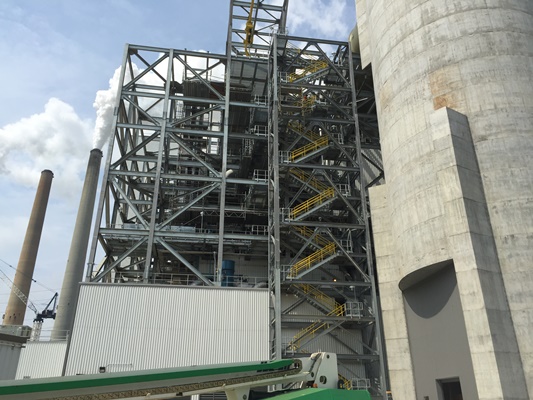Access to a rooftop project is rarely easy. When the project takes place 25 stories high at an electrical power plant, access becomes downright challenging.
This project was to apply a coated spray polyurethane foam (SPF) system to the rooftop of a boiler room at a Kentucky facility, which wishes to remain unnamed. It took not only a five-person crew from Spray-Tec, the SPF and coatings contractor, but also a partnership with surface prep experts R.K. Hydro-Vac. And both crews had to get access to the jobsite.
All Systems Go
The 30,000-square-foot (2,787.1 m²) built-up roof, which was 30 years old, was located through a gate, down a half-mile (804.7 km) road, followed by a 400-yard walk, up 13 floors, and finally up another 2 floors to the rooftop. It was deteriorating and leaking, and it had 30 years of buildup. It’s no surprise that Spray-Tec brought in the big guns for the surface prep portion of the ~225-foot-tall (68.6 m) job.
According to Spray-Tec Estimator Anthony Palmer, working with R.K. Hydro-Vac allowed them to offer the client a roof restoration rather than a complete roof replacement, which also meant saving them money. “You can imagine having to have a crane on site for heights of that magnitude, hoisting equipment, lowering roofing debris from tear off. It’s going to be a slow, very expensive process,” Palmer explained. “And we were able to save our customer a good chunk of money just by eliminating that costly tear off.”
The roof was a good candidate for this renovation, and the R.K. Hydro-Vac/Spray-Tec duo was ready to get it done.
It took around seven days for R.K. Hydro-Vac to remove the old gravel and power wash the substrate — all simultaneously, safely, and ecologically. “All the water that we used is vacuumed back into the truck, and that water is treated through a treatment plant before it goes back into any lakes or rivers or anything like that,” said Jason Lowder, field production manager for R.K. Hydro-Vac, which has multiple locations to service the United States.
Working about 10 to 12 hours a day, Lowder’s crew stayed at least a day ahead of the Spray-Tec team, which was on site assembling equipment and replacing any saturated areas. Working in this sequence enabled close communication, which helped Lowder’s crew ensure the substrate was as clean as Spray-Tec needed it to be.
To get it there, Lowder had a three-person crew — one guy leading and directing where to work and the other two manning the hose — and their proprietary system. “Basically, it’s a cleaning head that fits onto our vacuum hose that sprays high pressure atomized jets of water at the roof, and it pressure washes and vacuums all of the dirt and water in a single process in a single step,” Lowder explained. This allowed them to avoid the multiple steps it would have taken the Spray-Tec crew to remove material, pressure wash, and squeegee the water into rooftop drains. “It eliminated quite a bit of work for the SPF [spray polyurethane foam] contractor,” he continued.

As Palmer explained, “So where it would take us two [steps], and we’d have to clean it multiple, multiple times after we’re done, they get it done in one [step], and the very next day when that portion is dry, we can begin our install immediately. So you can imagine, it definitely saves us time — saves our laborers more than anything — from that back breaking work to remove the rock.”
Once up top, R.K. Hydro-Vac’s crew worked diligently but safely. “The height of the building was probably the biggest challenge,” Lowder said. “When we run our vacuum hose on something that high, we have to take extra time and safety precautions.” They put safety first on this and every project. Not only do all of their workers complete the 30-hour Occupational Safety and Health Administration (OSHA) training, but they’re also certified in CPR and safety for hoisting and using hand tools.
The extra time and safety efforts on this project paid off; Spray-Tec was impressed. “They’re a great company, top notch, very safe, and one that we recommend to any other roofer who needs ballast removal,” Palmer said. “They really have a great and efficient service.”
Hot, Hot, Hot!
Working on the roof of a boiler room provided its own set of challenges for both crews. It was the peak of a southern summer, which meant working under constant sun at 90-degree (32.2 °C) heat. And stepping inside brought zero relief for the crew.
Because the rooftop fans were turned off for the duration of the 20-day project, the areas inside and out of the sun reached 130‒180 °F (54.4‒82.2 °C). “It was insanely hot,” Lowder said.
The heat — inside and outside — meant paying particularly close attention to safety. The coatings crew took water, Gatorade, and Popsicle breaks, and they rotated the guy on the sprayer to keep fresh.
Fry-Free Roof
As you would imagine, prep for the Spray-Tec crew was minimal. They used Honda power washers, backpack blowers, and Gaco Western’s GacoFlex E5320 epoxy primer on the walls along the edge of the roof to ensure proper foam and coating adhesion. “Then we began the long task of foaming the roof and walls,” said Project Manager Quin Heisler.

It took them a week and a half to apply the spray polyurethane foam (SPF) and topcoat. Wearing suits, gloves, goggles, spray socks, hard hats, MSA respirators, and 3M ear plugs, the crew applied two passes of Gaco Western’s 3-pound (1.4 kg) closed-cell spray foam called GacoRoofFoam 2733. Anything that was covered in the average 1.5 inches (3.8 cm) of SPF had to be coated with an average 20-mil (508.0 microns) layer of GacoFlex S20 silicone the same day to avoid what Heisler called “fry-able foam.” (SPF is not resistant to ultraviolet rays). The crew applied the SPF, also called spray foam, with a Graco H40 and Fusion gun, and they applied the silicone with a Hennes-Johnson spray pump.
On top of the center roof, the crew applied another ~20-mil (508.0 microns) layer of the same silicone, this time including ceramic granules broadcast into it for anti-slip properties. According to Heisler, the ceramic also “helps prevent birds and critters, cuts down from the static, and also helps protect our foam.” The crew broadcast the granules with a hopper/blower from Roofmaster Products.
Throughout the entire project, the crew used flag stands. And when working within 6 feet (1.8 m) from the edge, they wore harnesses. Spray-Tec allows each crew member to pick his own fall protection because, according to Heisler, “if it’s comfortable you’re more likely to wear it.”
Hat Hung
“It was an extremely challenging job,” Heisler said. It didn’t hurt that three of his crew members have 25+ years’ application experience. “They are very skilled at what they do,” Heisler said.
Palmer concurred. “This crew was very resilient; they were very tough,” he said. They worked through heat and with heights. “But, you know, they did the project very safely and they knocked it out. The project went very smoothly,” he continued. “We couldn’t have been happier. I know our customer couldn’t have been happier. It was a great project and a good one to hang our hat on.”
